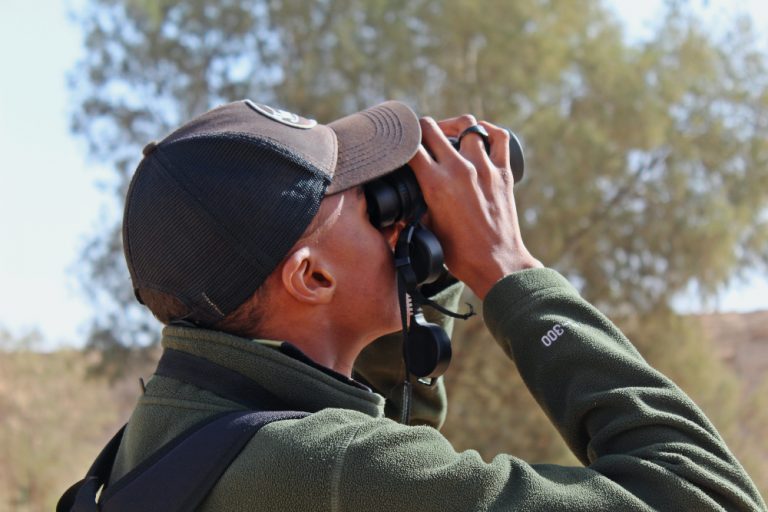
(The peak of Gacan Libaax in the distance, ”Gacan Libaax” means lion’s paw in the Somali language .) ©Abdurrahman Farhan
On 24th July 2022, I went with my cousins to a mountainous region in Somaliland called Gacan libax, Maarodi Jeex, not far from Laas Geel, and around 100 km (62 mi) east of the provincial capital Hargeisa. It is in the western part of the northern mountains, which extend east and west parallel to the northern coast of the Horn of Africa. (Credit Wikipedia)
The weather temperature ranged from 12*C at the coolest and 42*C at the hottest while I was there. This was during the hottest time of the year.

(A sign showing the direction to Gacan Libaax mountain.) ©Abdurrahman Farhan
From there it was roughly a five-hour drive to Gacan Libax. The ride was bumpy, the terrain rough, dusty and hot. There was almost no sign of life as the area was hit by a three-year long drought. Eventually we started to drive through a very windy sandy terrain close to a town called Cadadeley, around two hours from the Gacan Libax mountains. There I spotted an endangered species called the Speke’s gazelle (Gazella spekei). I also spotted a Kori bustard (Ardeotis kori) as I was trying to photograph the Speke’s gazelle.

(A petrol station outside Hargeisa right next to the Berbera Road, most petrol stations in Hargeisa have been changed to more modern looking ones.) ©Abdurrahman Farhan

(Speke’s gazelle spotted 50km away from Gacan Libaax mountains ) ©Abdurrahman Farhan


(Speke’s gazelle startled by us) ©Abdurrahman Farhan

A Kori bustard -Ardeotis kori- (on the left), is the largest flying bird native to Africa. A Desert Warthog -Phacochoerus aethiopicus ssp. Delamerei- (top right). ©Abdurrahman Farhan

Buxus hildebrandtii (top left) and Juniperus procera (right). ©Abdurrahman Farhan

After paying the guide, we made camp. While we were doing this, one of the locals ‘accidently’ bumped into us, (news travels fast in the bush, via bush telecommunications). He told us that this place was much greener a year ago, adding that they haven’t been hit as hard as other parts of the country. He told us that if you dig in the empty river streams, you will find water within 20cm or so!
After trying the experiment out, we laid camp and soon the darkness fell. The milky way that appeared was beautiful. Stars winked and twinkled like a bag of diamonds spilt on a sheet of black silk. Shooting stars ripped through the sky. The breeze was cooling in the still summer night.
Next day after spending my first night outside in the bush, I woke up and decided to do a little birding venture. The birds I spotted were phenomenal. Compared to the British Isle birds that I’m used to, these were a treat. I spotted three species of hornbill. There were also a myriad of sunbirds, Columbiformes and Drongos.
We had our breakfast. while we were eating, an extremely tall man greeted us. I was bit taken aback as we were very far away from civilization. He told us his name was Ibrahim and that he walked from a town which was a day away (he looked like he just stepped out of his house, that’s how fresh he looked). He knew the area very well and offered to guide us to the Gacan Libaax mountain. We were very glad as we didn’t know the way.
We set off after breakfast, riding out of our camp site and through a dry riverbed. It was a rough long two-hour ride from the end of the Gacan libaax mountain range, and we started to slowly climb (with the car) up the mountain peak.

©Abdurrahman Farhan



(British Colonial house located on top the mountain.) ©Abdurrahman Farhan

©Abdurrahman Farhan

(The view on top of Gacan Libaax. Left, top right and bottom). ©Abdurrahman Farhan

©Abdurrahman Farhan

(The spot where I spotted the Vervet monkey.) ©Abdurrahman Farhan
The list of the birds I *saw* in Gacan libax *were*:
Black-bellied Starling Notopholia corusca
Three-banded Plover Charadrius tricollaris
Pale Flycatcher Agricola pallidus
Somali Bunting Emberiza poliopleura
Greater Honeyguide Indicator indicator
Somali Fiscal Lanius somalicus
Chestnut-bellied Sandgrouse Pterocles exustus
Bruce’s Green-Pigeon Treron waalia
Laughing Dove Spilopelia senegalensis
White-bellied Go-away-bird Corythaixoides leucogaster
Hemprich’s Hornbill Lophoceros hemprichii
Eastern Yellow-billed Hornbill Tockus flavirostris
Von der Decken’s Hornbill Tockus deckeni
Madagascar Bee-eater Merops superciliosus
Grey-headed Batis Batis orientalis
Rock Martin Ptyonoprogne fuligula
Violet-backed Starling Cinnyricinclus leucogaster
Somali Starling Onychognathus blythii
Magpie Starling Speculipastor bicolor
African Collared Dove Streptopelia roseogrisea
Hooded Vulture Necrosyrtes monachus
Ethiopian Swallow Hirundo aethiopica
Red-billed OxpeckerBuphagus erythrorynchus
Olive Sunbird Cyanomitra olivacea
Mouse-coloured Sunbird Cyanomitra veroxii
Rufous-crowned RollerCoracias naevius

(Grey go-away-bird Corythaixoides concolor ) ©Abdurrahman Farhan

(Madagascar Bee-eater Merops superciliosus) ©Abdurrahman Farhan

(Eastern yellow-billed hornbill Tockus flavirostris) ©Abdurrahman Farhan

(Von der Decken’s hornbill Tockus deckeni) ©Abdurrahman Farhan

( A Hemprich’s hornbill Tockus hemprichii ) ©Abdurrahman Farhan

(A male and female Somali starling O. blythii, the female could be identified because of the grey head) ©Abdurrahman Farhan
More photos of my trip to Somaliland

(A Gerenuk Litocranius walleri, a near threatened species) ©Abdurrahman Farhan

(A Somali-desert warthog amiably strolling through the bush.) ©Abdurrahman Farhan

(A young girl herding her families sheep through the bush.) ©Abdurrahman Farhan

(A beautiful sight) ©Abdurrahman Farhan

(Army ants marching across a dried out riverbed).©Abdurrahman Farhan

(An Agma looking warily at the lens) ©Abdurrahman Farhan

(View from the top of Gacan libaax) ©Abdurrahman Farhan

(The valley underneath the Gacan Libaax mountains.) ©Abdurrahman Farhan

(Gacan Libaax) ©Abdurrahman Farhan

(The Berbera road leading into Hargeisa.) ©Abdurrahman Farhan

Abdurrahman is a wildlife fanatic who absolutely loves nature and the outdoors, he is regularly birdwatching and photographing wildlife. If you can’t find him birding or crouching behind a patch of reeds taking photos of waders, you will probably find him trail-running or cycling in the closest national park.





Pingback: Dragons are real, enter the world of komodo dragons -